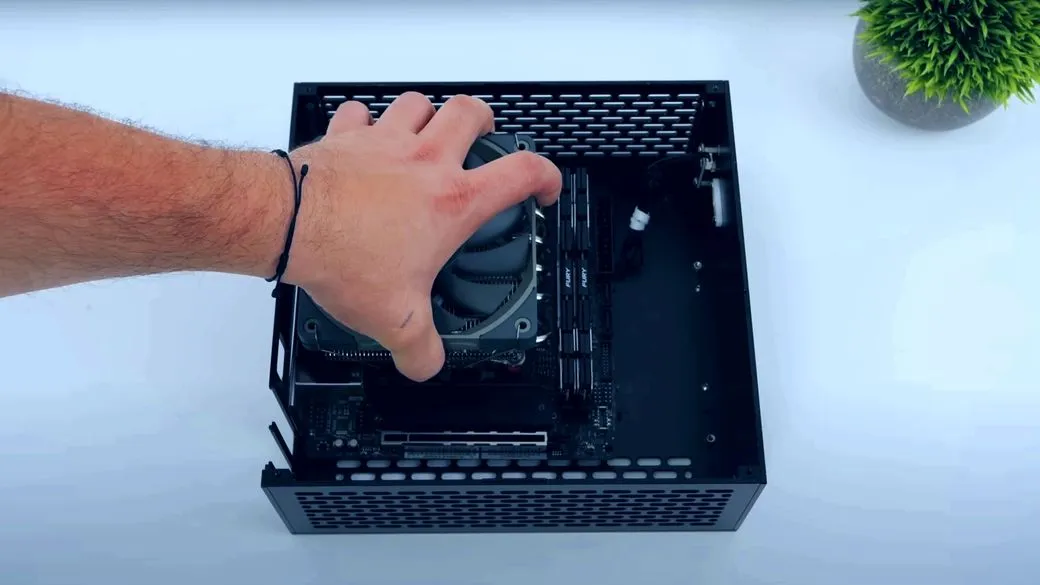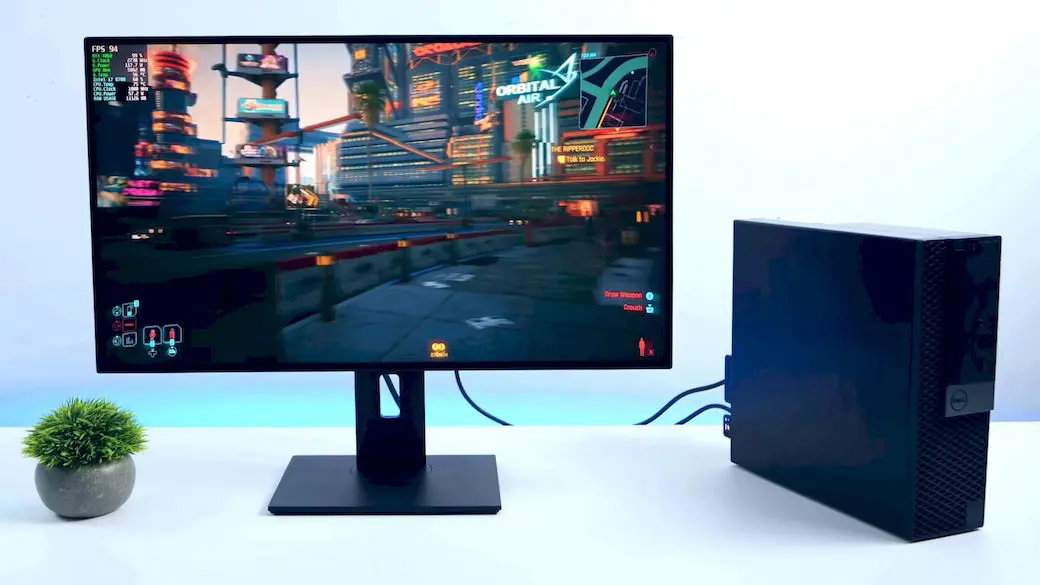Ryzen 9700X in a Mini ITX Case? Here’s the Smallest SFF Build!
September 6, 2024 | by Smith Elsie

Returning with one of the most interesting micro PCs of 2024 is ETA Prime! We’re putting together an incredibly small Mini ITX gaming PC today that has the power to handle 1440p games. This small form factor (SFF) setup, which has a GPU and CPU from AMD’s latest Ryzen 9 9700X, weighs only 4.6 liters. I’ll go over the parts I used, how to assemble it, and what kind of performance this little beast can offer you in this post.
Prior to delving into the build, allow me to briefly thank Ur CD Keys, our sponsor. Use code ETA to receive a 25% discount on software keys, such as Windows 10 Pro or Microsoft Office, if you require them at a reasonable price.
Parts List Breakdown
1. Motherboard: ASRock A620 Lightning Mini ITX
The ASRock A620 Lightning, one of the least expensive AM5 Mini ITX boards available, is the foundation of this setup. Even though AM5 Mini ITX boards might be pricey, the A620 provides an excellent trade-off between performance and affordability. It now fully supports Ryzen 9000 series processors thanks to a recent BIOS update.
2. CPU: AMD Ryzen 7 9700X
AMD’s Ryzen 7 9700X, a member of the Zen 5 family, is the CPU at the center of this setup. It offers outstanding performance in a little compact with 8 cores and 16 threads. The 7700X from the previous generation is still a fantastic choice if you’re trying to cut costs, and it’s rather common to find one on the used market.
3. RAM: 32GB Kingston Fury DDR5 7600 MHz
I chose 32GB of Kingston Fury DDR5 memory, which has a scorching 7600 MHz clock speed, for this setup. For AM5 systems, DDR5 is required. This configuration operates in dual-channel mode, offering great multitasking and gaming performance.
4. Storage: Kingston Fury 1TB M.2 PCIe 4.0 SSD
For modern gaming PCs, a fast SSD is essential, and the Kingston Fury 1TB PCIe 4.0 M.2 SSD is just that—rapid. This SSD guarantees rapid load times and snappy system responsiveness with its lightning-fast read/write speeds.
5. Cooler: Thermalright AX120 X67
It’s not easy to cool the Ryzen 9700X, especially with such a small chassis. I chose the Thermalright AX120 X67, a low-profile cooler with a 120mm fan, for this reason. Snugly fitting inside the chassis, its 67mm height allows it to effectively cool CPUs up to 130W.
6. Case: LZ MOD A24 V5 (4.6L)
The highlight of the presentation is this 4.6L case! Compact and simple, the LZ MOD A24 V5 case accommodates a low-profile, dual-slot GPU. It can fit all the parts we require, including the modular power supply and cooling system, despite its small size.
7. Power Supply: App EVIVA 500W Modular PSU
I used the App EVIVA 500W modular power supply to power everything. Because of its complete modularity, which is crucial for tiny form factor projects, neat cable management is possible. It’s an affordable alternative, well suited for this construction, costing only $50.
8. Graphics Card: RTX 460
This build is a perfect fit for the RTX 460. It provides a nice mix between size and performance with 8GB of GDDR6 RAM. The low-profile, dual-slot design fits perfectly in the 4.6L case. An RTX 3050 is a good choice if you just want to play games in 1080p, while the 460 has more capacity for 1440p games.
Assembly Process
It can be challenging to build in a small form factor enclosure like the LZ MOD A24, yet everything worked perfectly when the proper parts were used. The minimal amount of wire clutter was made possible by the modular power supply, and the Thermalright AX120 X67 cooler was a perfect fit for the case’s narrow dimensions.
Performance
I installed Windows 11 Pro, updated all the drivers, and ran some benchmarks after the build was finished. Outstanding performance was achieved by the Ryzen 9700X and RTX 460 combination, particularly for a system this compact.
Gaming Performance:
- 1080p: Can easily run most AAA games at 60 frames per second or more on high settings.
- 1440p: With medium to high settings, many contemporary games can be played at 60 frames per second, thanks to the RTX 460’s power.
Initial Setup and BIOS Settings
We’re using an ASRock A620 Lightning Mini ITX board this time around instead of the MSI motherboard I used in my last build. I haven’t changed the BIOS in a long time, other than turning on the RAM’s XMP profile. Notably, this setup has a lower TDP (Thermal Design Power) than anticipated. We’re observing a TDP of 87 watts with the most recent BIOS update, down from 140 watts with my previous design, which had a more powerful cooler. The small form factor requires careful power and cooling management, albeit this is adjustable.
Performance Benchmarks
Synthetic Benchmarks:
- Geekbench 6:
- Single-Core: 3,349
- Multi-Core: 16,745
- The Ryzen 7 9700X outperforms the Ryzen 7 7700X by 13% in multi-core performance and 14% in single-core performance.
- Cinebench R24:
- Multi-Core Score: 1,15 (Note: The exact score seems incomplete; please verify for accuracy.)
- 3DMark:
- Steel Nomad 2: 2,94
- Fire Strike: 26,372
- Time Spy: 11,3
Considering the size of the enclosure, these results are remarkable and highlight the powerful performance of the Ryzen 9700X and RTX 460 in this compact configuration.
Gaming Benchmarks:
- Call of Duty: Modern Warfare 3 (1440p, Ultra Settings):
- Average FPS: 171
- 1% Low: 78
- Frame Generation from NVIDIA helps improve performance at 1440p, resulting in a fluid experience.
- Cyberpunk 2077 (1440p, Ultra Settings, DLSS Auto):
- Average FPS: 84
- This demanding game runs smoothly on the RTX 460 @ 1440p, especially with DLSS.
- Red Dead Redemption 2 (1440p, Ultra Settings, DLSS Quality):
- With high settings, this game looks amazing at 1440p, however I had to change certain things to get a smooth run on this modest build.
- Fallout 4 (1440p, Ultra Settings):
- FPS: 144
- Unexpectedly strong frame rates for such an old game, demonstrating the RTX 460’s power even at maximum settings.
- Horizon Forbidden West (1440p, High Settings, DLSS Balance):
- Frame Generation is essential here for 1440p gaming. While it’s playable, I hope for future optimizations to improve performance further on lower-end cards.
Thermals and Power Consumption
During testing, I monitored both CPU and GPU temperatures and power consumption:
- CPU TDP: Averaged around 67 watts, peaking at 88 watts during intense gaming sessions. The Ryzen 9700X can push higher, but thermals are a limiting factor in this build.
- CPU Temps: Average of 58°C, with a maximum of 77°C. The Thermalright AX120 X67 cooler performs admirably in this confined space.
- GPU Temps: Average of 54°C, with a maximum of 74°C.
Considering the compact form factor, the thermal performance is outstanding, and the cooling techniques employed have managed heat well.
Conclusion
This 4.6L mini ITX configuration, with the Ryzen 9700X and RTX 460, is one of the best small gaming configurations for 2024. With the aid of Frame Generation and DLSS, it manages to give good 1440p gaming even though the top-end performance is limited by the lack of a more potent low-profile GPU. This configuration is a great option if you’re looking for a compact yet potent gaming PC.
Please leave a comment if you have any queries or if you would like to see more operating system testing or benchmarks. I appreciate you seeing, and I hope this in-depth look at one of the greatest little PCs of the year was enjoyable!
Video review of Ryzen 9700X SFF Mini ITX Gaming PC
RELATED POSTS
View all







